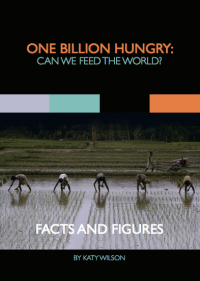The UN Food and Agriculture Organisation in their 2012 State of Food Insecurity report estimate the number of hungry in the world to be 868 million, 852 million of which are in developing countries. This is down from their past estimates of 925 million in 2010 and 1.02 billion in 2009.
The FAO, over the past year, has been in the process of improving its methodology for calculating chronic hunger and reviewing its data sources to reflect a more multidimensional view of food insecurity. Such revisions were called for by the Committee on World Food Security in 2011 and have resulted in this updated figure. Most notably FAO’s calculation of its undernourishment indicator has been adjusted and is thought to have declined more steeply up to 2007 than previous estimates while the actual impact of recent food price spikes on the number of hungry was less than originally thought.
There are reasons, however, why the 868 million should be considered conservative. For example, the calculation of food available for household consumption doesn’t take into account food wasted and while resource-poor households are unlikely to waste precious food, the FAO does recognise that “this effectively makes the FAO Prevalence of Undernutrition estimate a conservative indicator of food insecurity”.
868 million can also be considered conservative because the caloric threshold used to calculate the proportion of undernourished is the minimum of the range of energy requirement values (individuals receiving less calories than this minimum are considered undernourished). In determining the minimum value, reference is made to a Physical Activity Level (PAL), which for the FAO’s purposes is set at a ‘sedentary lifestyle’. Given that an estimated 80% of the hungry are farmers, a sedentary lifestyle is not representative of their energy output, and indeed for many of the world’s poor the burden of physical labour is high.
For a ‘normal activity’, whereby the minimum calorie threshold is slightly higher, there are 1.52 billion people in developing countries hungry and for ‘intense activity’ the number totals 2.56 billion, almost half the population of the developing world.
The FAO hunger number is designed to reflect the number of people suffering from chronic hunger around the world as opposed to acute hunger, for example in famine and humanitarian emergency situations, and as such the estimate is of the number of people who are hungry over a period of a year. This is argued to be too long a period, given that some people may be hungry for only months at a time, rather than a full year and yet could be considered chronically hungry. This is especially true of farmers who may eat well during the harvest but go hungry in the lean season. And again this would mean the FAO figure is an underestimate.
The FAO acknowledges the data and methodology-related issues that exist when calculating the number of hungry in the world. Based largely on statistical inference as well as household surveys largely concerning food acquisition rather than consumption, the estimate is unlikely to accurately represent the real situation. The FAO will continue to modify its methodology including the use of new indicators to capture a more accurate picture of food insecurity.
For now though, the fact that 868 million people in the world are chronically hungry, whether conservative or not, is unacceptable.









[…] for the period 2010-2012 (details of their methodology and revised estimates can be found in a previous blog post). The new calculations indicate that the prevalence of extreme malnourishment peaked in 1990, then […]